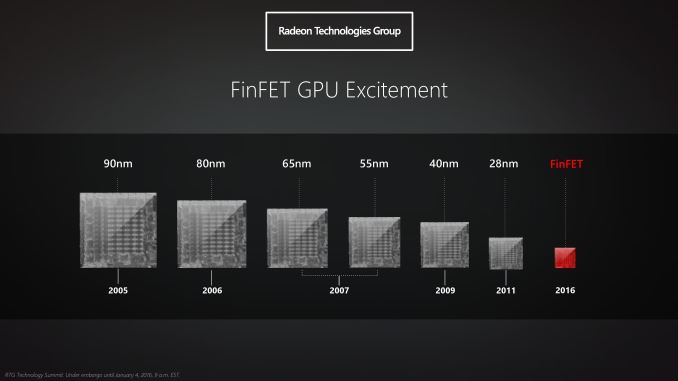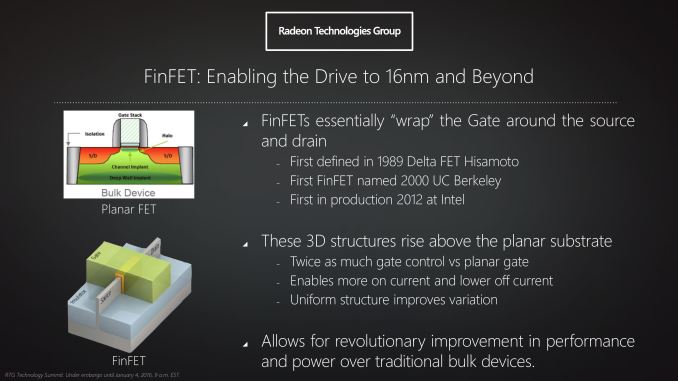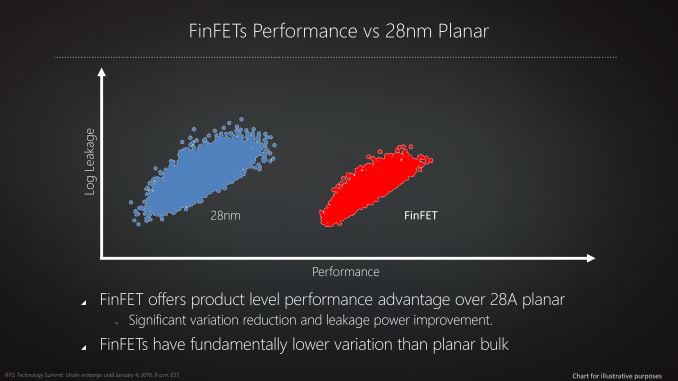AMD Reveals Polaris GPU Architecture: 4th Gen GCN to Arrive In Mid-2016
by Ryan Smith on January 4, 2016 9:00 AM ESTPolaris: Made For FinFET
The final aspect of RTG’s Polaris hardware presentation (and the bulk of their slide deck) is focused on the current generation FinFET manufacturing processes and what that means for Polaris.
As RTG’s slide concisely and correctly notes, the regular march of progress in semiconductor fabrication has quickly tapered off over the last decade. What was once a yearly cadence of new manufacturing processes – a major new node every 2 years with a smaller step in the intermediate years – became just every two years. And even then, after the 20nm planar process proved unsuitable for GPUs due to leakage, we are now to our fifth year of 28nm planar as the leading manufacturing node for GPUs. The failure of 20nm has essentially stalled GPU manufacturing improvements, and in RTG’s case resulted in GPUs being canceled and features delayed to accommodate the unexpected stall at 28nm.
For their most recent generation of products both RTG and NVIDIA took steps to improve their architectural efficiency due to the lack of a new manufacturing process – with NVIDIA having more success at this than RTG – but ultimately both parties were held back from what they originally were planning back around 2010. So to say that the forthcoming move to FinFET for new GPUs is a welcome change is an understatement; after nearly half a decade of 28nm GPUs we finally will see the kind of true generational improvements that can only come from a new manufacturing node.
To no surprise then, RTG is aggressively targeting FinFET with Polaris and promoting the benefits thereof. With power efficiency essentially being the limiting factor to GPU performance these days, the greatest gains can only be reached by improving overall power efficiency, and for RTG FinFETs will be a big part of getting there. Polaris will be the first RTG architecture designed for FinFETs, and coupled with the architecture improvements discussed earlier, it should result in the largest overall increase in performance per watt for any Radeon GPU family.
We’ve already covered the technical aspects of FinFET a number of times before, so I’m not going to go into too much depth here. But at the most basic level, FinFETs are the solution to the leakage problems that have made planar transistors impractical below 28nm (and ultimately killed 20nm for GPUs). By using multiple fins to essentially make a transistor 3D, it becomes possible to control leakage in a manner not possible with planar transistors, and that in turn will significantly improve energy efficiency by reducing the amount of energy a GPU wastes just to be turned on.
With the introduction of FinFET manufacturing processes, GPU manufacturing can essentially get back on track after the issues at 20nm. FinFETs will be used for generations to come, and while the initial efficiency gain from adding FinFETs will likely be the single greatest gain, it solves the previous leakage problem and gives foundries a route to 10nm and beyond. At the same time however as far as the Polaris GPUs are concerned, it should be noted that the current generation of 16nm/14nm FinFET processes are not too far removed from 20nm with FinFETs. Which is to say that the move to FinFETs gets GPU manufacturing back on track, but it won’t make up for lost time. 14nm/16nm FinFET is essentially only one generation beyond 28nm by historical performance standards, and the gains we're expecting from the move to FinFET should be framed accordingly.
As for RTG’s FinFET manufacturing plans, the fact that RTG only mentions “FinFET” and not a specific FinFET process (e.g. TSMC 16nm) is intentional. The group has confirmed that they will be utilizing both traditional partner TSMC’s 16nm process and AMD fab spin-off (and Samsung licensee) GlobalFoundries’ 14nm process, making this the first time that AMD’s graphics group has used more than a single fab. To be clear here there’s no expectation that RTG will be dual-sourcing – having both fabs produce the same GPU – but rather the implication is that designs will be split between the two fabs. To that end we know that the small Polaris GPU that RTG previewed will be produced by GlobalFoundries on their 14nm process, meanwhile it remains to be seen how the rest of RTG’s Polaris GPUs will be split between the fabs.
Unfortunately what’s not clear at this time is why RTG is splitting designs like this. Even without dual sourcing any specific GPU, RTG will still incur some extra costs to develop common logic blocks for both fabs. Meanwhile it's also not clear right now whether any single process/fab is better or worse for GPUs, and what die sizes are viable, so until RTG discloses more information about the split order, it's open to speculation what the technical reasons may be. However it should be noted that on the financial side of matters, as AMD continues to execute a wafer share agreement with GlobalFoundries, it’s likely that this split helps AMD to fulfill their wafer obligations by giving GlobalFoundries more of AMD's chip orders.
Closing Thoughts
And with that, we wrap up our initial look at RTG's Polaris architecture and our final article in this series on RTG's 2016 GPU plans. As a high level overview what we've seen so far really only scratches the surface of RTG's plans - and this is very much by design. But as the first occasion of RTG opening up their roadmaps and giving us a bit of a look into the future, it's a welcome change not only for developers, but for the press and public alike.
Backed by the first major node shrink for GPUs in over 4 years, RTG has laid out an aggressive plan for Polaris in 2016. At this point RTG needs to catch up and close the market share gap with NVIDIA - of this RTG is quite aware - and Polaris will be the means to do that. What needs to happen now is for RTG to fully execute on the plans they've laid out, and if they can do so then 2016 should turn out to be an interesting (and competitive) year in the GPU industry.





















153 Comments
View All Comments
Yaldabaoth - Monday, January 4, 2016 - link
That's where I am, too. I have a Zotac 9600 [something] that is begging to be retired. 1440p and (DirectX 12-compatible drivers) soon!Mondozai - Monday, January 4, 2016 - link
If you're still using a 9600 and haven't found a reason to upgrade thus far you never will.bodonnell - Monday, January 4, 2016 - link
Yup, the 9600 is more like 7+ years old and only supports up to DirectX 10. If that has suited your needs thus far you may not need to be first in line for this!Birra - Monday, January 4, 2016 - link
Mediudm preset 1080p ?Why did they not compare it to a GTX 750Ti with 60fps lock proof ?
AMD.... AMD....
mdriftmeyer - Monday, January 4, 2016 - link
They are comparing it to a current generation Nvidia card in the $150 - $170 price range and showing the results of performance/watt at that range for this card that isn't optimized yet. In short, the card will be in this price range with this new GCN architecture, FinFET, at a massive drop in power consumption and all the benefits in performance it will offer.This isn't a pissing contest about cherry picking a card for the hell of it. It's about specific retail pricing, perf/watt and power consumption.
extide - Monday, January 4, 2016 - link
Dude, it's just a very generic preview to kinda 'prove' that they are taking power consumption seriously. I mean think about it, AMD has taken MAJOR heat about their lack of efficiency in their recent GPU designs. Obviously they have heard this and are aware, and are making power consumption a 1st class citizen in terms of priorities. They are just trying to put some evidence out there that, "Yes, we hear you, we are working on this issue..."andrewaggb - Monday, January 4, 2016 - link
I'm glad the power numbers should be much better... but this article (while somewhat interesting) doesn't have enough information. It's exciting that we'll get new genuinely new GPU's this year from AMD and NV, with 10 bit color, HDMI 2, and lower power consumption... but I think we all pretty much knew that anyways.Mondozai - Monday, January 4, 2016 - link
The big takeaway for me was that we will not see mid-high range GPUs launch until the autumn at the earliest. Secondly, for all the talk about Polaris/Artic Islands being just a shrink of Fiji(tons of it in various forums), the article fleshed out that the changes are the biggest in at least 4 years. And then there's a ton of different stuff, like the new primitive discard accelerator etc.Yes, I would have liked to see more, but to pretend that we knew everything is either a lazy claim or a testament that you didn't read it carefully enough.
Jleppard - Monday, January 18, 2016 - link
Well where is any Nvidia information except car parts with fake chips.TallestJon96 - Monday, January 4, 2016 - link
May this be the last generation to suffer from the 275w+ maddness that is Hawaii. With the generational improvements since then (tonga and fury) plus a new manufacturing process, hopefully tdp can stay reasonable. I also hope we never see ddr3 graphics cards again, and gddr5 can makes its way down to the lower end of graphics cards.Exciting to have a really new generation of cards coming. Prices will probably be really high because of demand at first. And a card with 950 performance at sub 750 ti power levels sounds sweet, even if its an AMD tilted benchmark. Imagine what a real 750 ti replacement from NVIDIA could do.